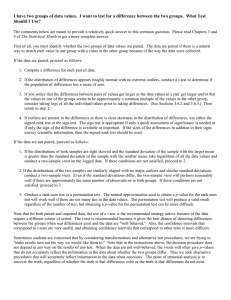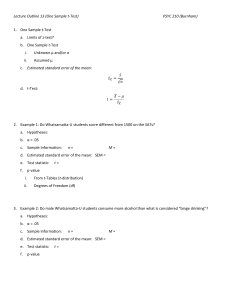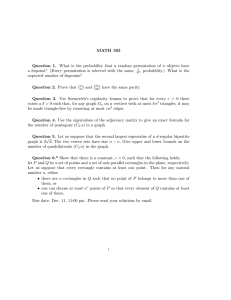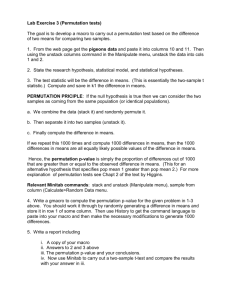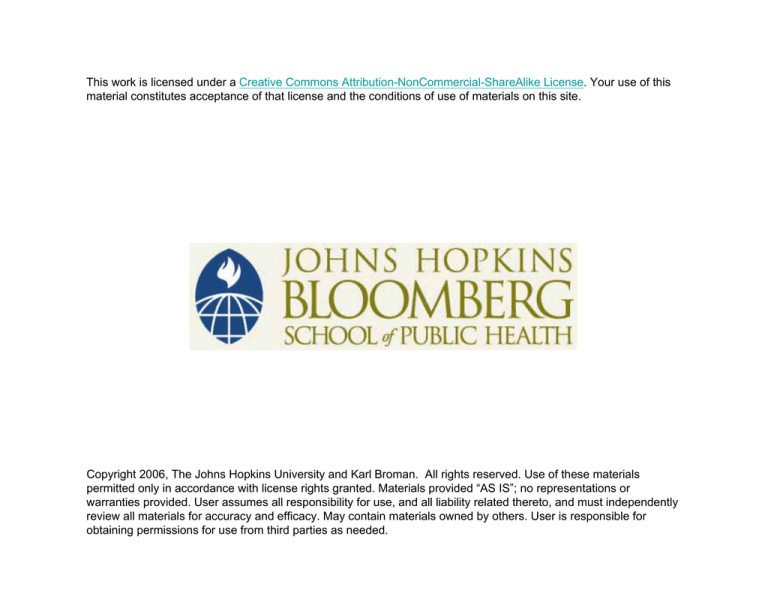
This work is licensed under a Creative Commons Attribution-NonCommercial-ShareAlike License. Your use of this
material constitutes acceptance of that license and the conditions of use of materials on this site.
Copyright 2006, The Johns Hopkins University and Karl Broman. All rights reserved. Use of these materials
permitted only in accordance with license rights granted. Materials provided “AS IS”; no representations or
warranties provided. User assumes all responsibility for use, and all liability related thereto, and must independently
review all materials for accuracy and efficacy. May contain materials owned by others. User is responsible for
obtaining permissions for use from third parties as needed.
Statistical tests
• Gather data to assess some hypothesis (e.g., does this
treatment have an effect on this outcome?)
• Form a test statistic for which large values indicate a departure from the hypothesis.
• Compare the observed value of the statistic to its distribution under the null hypothesis.
Paired t-test
Pairs (X 1, Y 1), . . . , (X n, Y n) independent
X i ∼ normal(µA, σA)
Y i ∼ normal(µB , σB )
Test H0 : µA = µB vs Ha : µA 6= µB
Paired t-test
Di = Y i − X i
D 1, . . . , D n ∼ iid normal(µB − µA,σD )
sample mean D̄; sample SD sD
√
T = D̄ /(sD/ n)
Compare to t distribution with n – 1 d.f.
Example
200
Y
180
X
100
120
140
160
180
160
200
Y
140
120
D
100
−10
0
10
20
30
40
100
110
120
130
140
150
160
X
D̄ = 14.7
sD = 19.6
n = 11
T = 2.50
P = 2*(1-pt(2.50,10)) = 0.031
Sign test
Suppose we are concerned about the normal assumption.
(X 1, Y 1), . . . , (X n, Y n) independent
Test H0 : X’s and Y’s have the same distribution
Another statistic: S = #{i : X i < Y i} = #{i : D i > 0}
(the number of pairs for which X i < Y i)
Under H0, S ∼ binomial(n, p=0.5)
Suppose Sobs > n/2.
P-value = 2 × Pr(S ≥ Sobs | H0)
= 2 * (1 - pbinom(Sobs - 1, n, 0.5))
Example
For our example, 8 out of 11 pairs had Y i > X i.
P-value = 2*(1 - pbinom(7, 11, 0.5)) = 23%
(Compare this to P = 3% for the t-test.)
Signed Rank test
Another “nonparametric” test. (This one is also called the Wilcoxon
signed rank test)
Rank the differences according to their absolute values.
R = sum of ranks of positive (or negative) values
D 28.6 –5.3 13.5 –12.9 37.3 25.0 5.1 34.6 –12.1 9.0 39.4
rank 8
2
6
5
10
7
1
9
4
3 11
R = 2 + 4 + 5 = 11
Compare this to the distribution of R when each rank has an equal
chance of being positive or negative.
In R: wilcox.test(d) −→ P = 0.054
Permutation test
(X 1, Y 1), . . . , (X n, Y n) −→ Tobs
• Randomly flip the pairs. (For each pair, toss a fair coin. If heads, switch X and
Y; if tails, do not switch.)
• Compare the observed T statistic to the distribution of the T-statistic when the
pairs are flipped at random.
• If the observed statistic is extreme relative to this permutation/randomization
distribution, then reject the null hypothesis (that the X’s and Y’s have the same
distribution).
Actual data:
(117.3,145.9) (100.1,94.8) (94.5,108.0) (135.5,122.6) (92.9,130.2) (118.9,143.9)
(144.8,149.9) (103.9,138.5) (103.8,91.7) (153.6,162.6) (163.1,202.5) −→ Tobs = 2.50
Example shuffled data:
(117.3,145.9) (94.8,100.1) (108.0,94.5) (135.5,122.6) (130.2,92.9) (118.9,143.9)
(144.8,149.9) (138.5,103.9) (103.8,91.7) (162.6,153.6) (163.1,202.5) −→ T? = 0.19
Permutation distribution
−5
−4
−3
−2
−1
0
1
2
3
4
5
P-value = Pr(|T?| ≥ |Tobs|)
Small n: Look at all 2n possible flips
Large n: Look at a sample (w/ repl) of 1000 such flips
Example data:
All 211 permutations: P = 0.037; sample of 1000: P = 0.040
Paired comparisons
At least four choices:
• Paired t-test
• Sign test
• Signed rank test
• Permutation test with the t-statistic
Which to use?:
• Paired t-test depends on the normality assumption
• Sign test is pretty weak
• Signed rank test ignores some information
• Permutation test is recommended
The fact that the permutation distribution of the t-statistic is generally well-approximated by a t distribution recommends the ordinary
t-test. But if you can estimate the permutation distribution, do it.
2-sample t-test
X 1, . . . , X n ∼ iid normal(µA, σ )
Y 1, . . . , Y m ∼ iid normal(µB , σ )
Test H0 : µA = µB vs Ha : µA 6= µB
X̄ − Ȳ
q
Test statistic: T =
sp 1n + m1
where sp =
q
s2A(n−1)+s2B (m−1)
n+m−2
Compare to t distribution with n + m – 2 degrees of freedom.
Example
Y
X
40
50
60
70
X̄ = 47.5
sA = 10.5
n=6
Ȳ = 74.3
sB = 20.6
m=9
sp = 17.4
80
90
100
T = –2.93
P = 2*pt(-2.93, 6+9-2) = 0.011
Wilcoxon rank-sum test
Rank the X’s and Y’s from smallest to largest (1, 2, . . . , n+m)
R = sum of ranks for X’s
X
35.0
38.2
43.3
Y
46.8
49.7
50.0
51.9
57.1
61.2
74.1
75.1
84.5
90.0
95.1
101.5
rank
1
2
3
4
5
6
7
8
9
10
11
12
13
14
15
(Also known as the Mann-Whitney Test)
R = 1 + 2 + 3 + 6 + 8 + 9 = 29
P-value = 0.026
(use wilcox.test())
Note: The distribution of R (given
that X’s and Y’s have the same
dist’n) is calculated numerically
Permutation test
X or Y
X1
X2
..
Xn
Y1
Y2
..
Ym
group
1
1
1
1
2
2
2
2
X or Y
X1
X2
..
Xn
Y1
Y2
..
Ym
→ Tobs
group
2
2
1
2
1
2
1
1
→ T?
Group status shuffled
Compare the observed t-statistic to the distribution obtained by
randomly shuffling the group status of the measurements.
Permutation distribution
−4
−3
−2
−1
0
1
2
n+m
n
3
4
5
6
7
P-value = Pr(|T?| ≥ |Tobs|)
Small n & m: Look at all
possible shuffles
Large n & m: Look at a sample (w/ repl) of 1000 such shuffles
Example data:
All 5005 permutations: P = 0.015; sample of 1000: P = 0.013
Estimating the permutation P-value
Let P = true P-value (if we do all possible shuffles)
Do N shuffles, and let X = # times the statistic after shuffling ≥ the
observed statistic
P̂ =
X
N
where X ∼ binomial(N, P)
E(P̂) = P
SD(P̂) =
q
P(1−P)
N
If the “true” P-value P = 5% and we do N=1000 shuffles, SD(P̂)
= 0.7%.
Summary
The t-test relies on a normality assumption
If this is a worry, consider:
• Paired data:
– Sign test
– Signed rank test
– Permutation test
• Unpaired data:
– Rank-sum test
– Permutation test
Crucial assumption: independence
The fact that the permutation distribution of the t-statistic is often
closely approximated by a t distribution is good support for just
doing t-tests.


